Introduction
Planning is the process used by organizations to create a series of steps that provide a roadmap and a framework by which required objectives can be met. Planning is undertaken by individuals, organizations both big and small, governments, not for profit and charities, in fact, all entities that want to achieve a set of objectives as per the set budget and time. If there is no planning or bad planning then things go awry, too many uncontrolled variables make an impact, and invariably the project is deemed to be a failure.
Modern-day projects in industries and construction cost millions of dollars and if proper project planning is not done, then there is a good possibility there the whole project would fail, resulting in millions of dollars being lost due to the project delays and lost opportunities. Planning and project management are highly evolved forms of management studies and practices and there are a number of complex tools and methods available for the proper planning and execution of a project. This paper researches the important aspects of planning, termed as the foundations of planning, discusses emerging concepts in this field, and also researches how large organizations take up planning. Some successful and failed projects have been also discussed.
What has been the historical development of this topic?
Planning has been practiced since the time the ancient Egyptians built the Pyramids and the Romans conquered Europe. Planning has always helped civilization move forward and has helped mankind to improve. Stephen (2002) defines planning as “involves defining the organization’s goals, establishing an overall strategy, and developing a comprehensive set of plans to integrate and coordinate organizational work”. According to the author, there are two types of planning, informal planning, and formal planning. An informal planning, nothing is written down or documented; instructions are given verbally with little or no sharing of goals and general and lacking in continuity.
A formal planning system has properly documented instructions with specific goals and specific action programs exist to achieve goals. Planning is the primary management function that establishes the basis for all other management functions and establishes coordinated effort, reduces uncertainty, reduces overlapping and wasteful activities, and establishes goals and standards used in controlling performance and actions.
Formal planning is associated with higher profits and higher returns on assets. Quality of the planning process and the appropriate implementation of the plans contribute more to high performance than does the extent of planning. External environment may undermine the effects of formal planning while planning and performance relationship is influenced by the planning period.
Why is it important for supervisors/managers to learn about this topic?
Stephen (2002) clarifies that the role of goals and Plans in Planning has to be understood first. Plans are an outline of how goals are going to be met. Goals are the desired outcomes, provide direction for all management decisions, and represent the criteria against which actual work results can be measured. There are different types of Goals and it should be remembered that while all organizations have multiple objectives, there is no single measure that can be used to evaluate if an organization is successful. Goals are of two types, financial and strategic. Financial goals elate to the financial performance of the company while strategic goals relating to functional areas of performance.
Thompson (1995) has provided a good comparison and difference between financial and strategic objectives and the author argues that both are essential for organizational success. The differences and comparisons are as illustrated in the following figure.
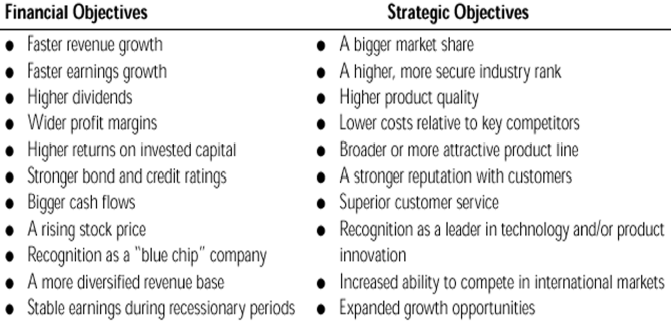
Thompson (1995) further comments that the goals may be stated goals or real goals. Stated goals are the official statements of the organization’s goals while real goals are those goals that an organization actually pursues. Strategic plans would apply to the entire organization, establish the organization’s overall goals and seek to position the organization in terms of its environment while the operational plans specify the details of how the overall goals are to be achieved and they tend to cover short time periods.
Thompson (1995) speaks of types of Plans as long-term, short-term, specific, and directional. Long-term plans have a time frame greater than three years but the definition of long-term has changed with increasingly uncertain organizational environments. Short-term plans are one year or less, specific plans are clearly defined with little room for interpretation and required clarity and predictability often do not exist.
Directional plans are flexible plans that set out general guidelines and provide focus without limiting courses of action. There are also single-use plans that are one-time plans specifically designed to meet the needs of a unique situation and standing plans that are ongoing plans that provide guidance for activities performed repeatedly and include policies, procedures, and rules.

What should you know about this to be a better supervisor/ manager?
It is important that to be a better supervisor/ manager, one should know about goal setting and steps in planning. Goal setting is done by two methods, traditional goal setting and management by objectives. In traditional goal setting, overall goals are established at the top of the organization and overall goals broken down into sub goals for each level of the organization. The higher-level goals must be made more specific at lower levels and network of goals creates a means-ends chain and the sub goals constrain subordinates behaviour. This method assumes that top managers know what is best for the organization. Following figure illustrates the method used for traditional goal setting (Stephen, 2002).

Management by objectives – MBO allows for specific performance goals to be jointly determined by employees and the managers and the progress toward accomplishing these goals is periodically reviewed. Rewards are allocated on the basis of this progress. MBO has four elements and these are: goal specificity, participative decision making, explicit time period and performance feedback. The method increases employee performance and organizational productivity and depends on support of top managers for MBO. Following figure lists the steps involved in MBO.

There can be some problems with MBO and it can be useless in times of dynamic change. There is an overemphasis on personal rather than organizational goals and may be viewed simply as an annual exercise in paperwork.
Steps in Planning
Stephen (2002) points out that that a well thought out and defined plan has a number of characteristics. Plans should be written in terms of outcomes and should specific goals and results that are measurable and quantifiable. The plans should be clear with reference to period and while they can be challenging, they should be attainable. It is a good practice to document the plans and there should be clear communication in the organization with members who are concerned about the plans being made aware of the plans (Stephen, 2002).
Steps in planning and goal setting are: Review the organization’s mission; Evaluate available resources; Determine the goals individually or with input from others and they should be congruent with the organizational mission and goals in other organizational areas; write down the goals and communicate them to all who need to know them and review results and whether goals are being met.
Certain Contingency Factors should be considered in Planning and the level in the organization; operational planning dominates managers; planning efforts at lower levels and the strategic planning more characteristic of planning at higher levels should be considered. The traditional, top-down approach had planning done by top managers along with a formal planning department and a team of specialists whose sole responsibility was to help to write organizational plans, plans flowed down to lower levels and that were tailored to particular needs at each lower level. These are most effective if plan is a workable document used by organizational members for direction and guidance.
It used an inclusive approach and employees at each level develop plans suited to their needs. Employees acquire greater sense of the importance of planning when they participate in the process and plans more likely to be used in directing and coordinating work (Stephen, 2002).
Criticisms of Planning
There are some criticisms of planning and while some of these criticism are academic, the rest are worth considering. There is the fear that planning may create rigidity and it is unwise to force a course of action when the environment is fluid. Another critique is that plans can’t be developed for a dynamic environment and where flexibility is required in a dynamic environment and they can’t be tied to a formal plan.
There is also a fear that formal plans can’t replace intuition and creativity and that mechanical analysis reduces the vision to some type of programmed routine. Planning also focuses on managers’ attention on today’s competition, not on tomorrow’s survival and plans concentrate on capitalizing on existing business opportunities. In some cases, planning also hinders managers who consider creating or reinventing an industry. Formal planning reinforces success, which may lead to failure and success may breed failure in an uncertain environment (Stephen, 2002).
Understanding Project Success through Planning
Bourne (2005) suggests that the success or failure of a project depends on three pillars of planning and these are delivering value in terms of cost, time, scope and benefits realisation; managing relationships with stakeholder expectations and managing risk through corporate governance and procurement. He regards these as the pillars of success for a project. Given below is an illustration.
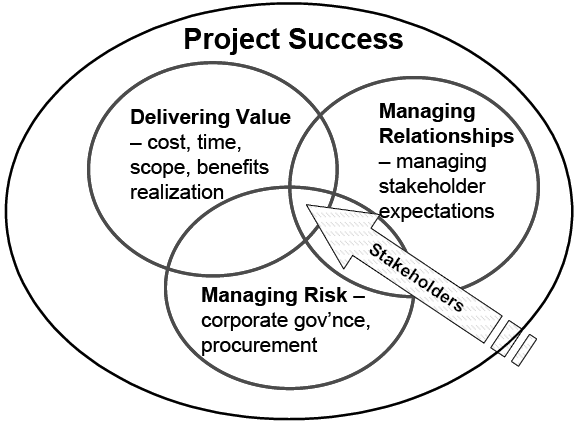
Bourne brings up the term ‘successful failure’ meaning that even after a project has successfully met the objectives of cost, schedule and time, it is still regarded as a failure. The author has mentioned the ‘dirty dozen’ reasons for project delays and while some of them are due to the contractors fault, other are due to different reasons, beyond the control of the designer and the contractors. Please refer to the following figure.
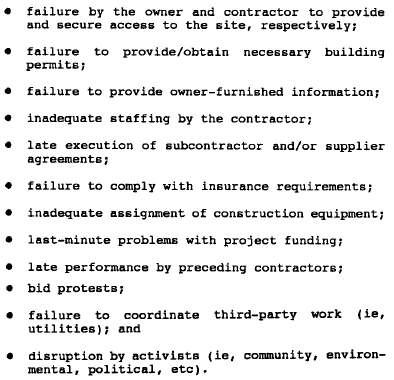
Bourne (2005) has conducted a survey among 30 project managers from leading construction firms where the project cost varied from 660 million Euros to 2.2 billion Euros. The study was aimed at understanding how industry experts regarded ‘project failures’. The author concludes that “success or failure can only be determined after a project ends and not after project completion and this means at the end of the life of the project, at the point the overall driving business objectives are no longer required“.
How have organizations applied knowledge in this area?
According to McGeorge (et all, 2002), a modern organizations has to balance customer requirements and deadline with quality and value management. Large projects that would be expected to run for more than a year and would involve thousands of person hours would have various teams such as designers, estimators, excavators, surveyors, rock blasters, foundation specialists, RCC crew, flooring and walling crew, electrical and plumbing teams, weather proofing and safety teams, finishers and so on.
All these teams do not work at the same time on a project but rather come in as per different phases meaning that the output of one team would serve as the input for another and each team would have a fixed deadline within which they need to complete their tasks. Construction management is deemed to be effective when each team completes its time as per the schedule, there is no overlap where one team has to wait for the other to complete the work and a sufficient buffer is kept for each phase to accommodate overlaps..
Managing Complexities through planning
Kelly (et all, 2002) argues that in the past few decades, construction has moved from a model of ‘slow and steady’ to ‘the quick and the successful’ and he has suggested that the UK construction industry that steadfastly refused to accept modern management practices, has been forced to change its stance and in short ‘the workhorse has learned to canter’. A construction project is like a vast jig saw puzzle that needs to be put together but one does not have all the pieces, rather they have to be prepared individually, ensure that they fit the requirements and are available at the right time and place. The complexities begin with the nature of construction and include issues such as success factors, organizational structure and finances.
Nature of Construction Projects
Pryke (et all, 2006) has observed that the nature of construction extends beyond cement, steel, gravel and covers concepts such as value management, understanding requirements, being able to foresee pitfalls and areas that are prone to delay. In addition, construction is an all year process, except in extreme adverse condition and the crew is exposed to harsh weather. There are at least two parties, owner who pays for the project and the builder who designs and builds the project and accepts payments. There are other entities such as architects and RCC consultants, excavation contractors, raw material vendors and many others and the project management office of the builder usually manages these entities.
There are many categories of structures and these include residential complexes, houses, schools, hospitals, office and entertainment complexes, roads and highways, dams and other large infrastructure and so on. The author points out that builders tend to specialize in a specific type of construction and there may be some lateral movement among these categories. So a builder who specializes in office buildings would not be willing to take up building of roads or dams. In addition, the equipment, type of crews, mobility of personnel, managing logistics is different for each category.
Success Factors in Construction Management
Chileshe (2005) points out that construction projects typically have a number of stakeholders such as contractors, sub contractors, main contractors, consultants and so on. Each of these stakeholders has a set of specific tasks to be completed. Please refer to Figure 1.
Construction Requirement Framework. The figure shows the value chain that is created in a typical construction project. The total project plan can be thought of as a chain and each stakeholder forms a link in this chain. Project management techniques attempt to ensure that the tasks are planned on time and as per schedule. Individual links in the chain are sized and appropriate buffers provided so that not only does the link perform as per the plan but attempts to deliver ahead of the schedule. Creating a viable and sustainable value chain is the key factor for success.
The generic success factors include: making optimum use of available funds and resources, scope control of the project, scheduling the project and work breakdown for different tasks and phases, proper design, avoiding delays, disputes and changes to the building; managing raw material suppliers and sub contractors and managing the cash flow (Gruneberg, 2000).
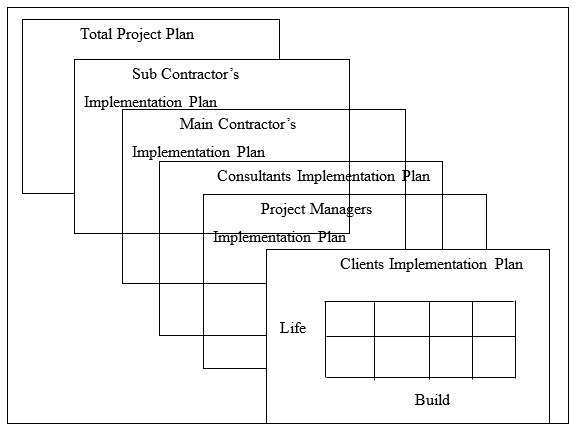
Organization Structure
According to the studies reported by Cheng (et all, 2003), the organization structure of construction firms tends to be elastic and depends on the size, complexity and single or multiple locations of the project.
However the authors suggest that there should be a central project management office that frames the project plan and that would interface with the clients on one side and other entities such as the architects, subcontractors, equipment suppliers, raw material vendors, various government agencies and so on. When larger projects are involved, there should be a site manager office that would look after the day-to-day activities such as managing labour, arranging for payments, ensuring that the project plan is followed. Importance is given to communications and the use of email; fax machines and where possible, video conferencing. Communication should not act as a hindrance to decision-making but rather increase the pace. Please refer to the following figure that illustrates an organization structure.

The authors have suggested that further levels in the organization should be need based so a project manager would have a number of engineers who would follow the project plan and provide timely feedbacks, project status and so on. These would be arranged as per requirements such as design, stores, purchase, finance and accounts, front office, sales and so on.
Planning for Finance, Firm Structure and Activities
Kelly (2002) has emphasized the importance of maintaining budgets and adhering to deadlines in the construction industry where cash flow problems can stop the project midway. When sub contractors are used to supply labour, machines and raw material, these people usually demand a much shorter payment cycle that may be weekly but the customer on the other hand would be paying after certain stages and phases are completed. The construction firm has to bear the costs in the intervening period and it is up to the company to decide how much financial exposure it can bear. In situations where money position is tight, any delays affect the project health and incidents when costly machines such as excavators, bulldozers, graders along with their crew are forced to sit idle can severely effect the profitability of a firm.
Examples of Projects
There are some arguments about defining what is a successful project and what is a failure. Udechukwu (December 2007) observed that there should not be haste in judging complex projects. According to the author, whether a project is a success or a failure can be judged after the project ends and not necessarily after project completion. Project completion refers to the phase when building activities cease while project end happens when the life of the structure is over. Some examples of complex projects, both successful and failed are given.
The Scottish Parliament Building
The structure was to be built at Holyrod and started in 1997 and the budget was 40 million GBP. However, due to addition in project definition and scope, needless intervention by politicians and long delays for approval, the project was completed in 2004 at a cost of 430 million GBP. At the time when it was ready, there was an outcry that the project was a failure but now it is regarded as a good architecture (White, 2005).
The Channel Tunnel
Designed to connect UK and France, the Chunnel was to start in 1992 and was budgeted at 1.27 billion GBP. There were many variables such as unknown underwater geology of the rocks, funding delays, political intervention, contractor disputes and so on and these were not specified in the project scope. The project was ultimately made ready in 1994 and the cost was 4.65 billion GBP (AP, July 17, 2008).
The Port Adelaide Flower Farm Project
This is a worst example of a failed complex project. The Port Adelaide Flower farm project – PAFF was approved by the South Australian Minister of Local Government at Port Adelaide for setting up a farm. The farm was to come up on the LeFevre Peninsula and was designed to grow native plants such as Geraldton Wax flowers and Kangaroo Paw and exporting the produce to Japan and Australia. Work commenced in September 1988 and due to financial losses and non remunerative and viable methods, the project was closed in August 1995. The business plan had omitted to go into the specifics of the nature of the flowers, market analysis, target customer preferences, rates, cost of growing and FOB rates and even if the plants could be grown in the area. The whole project was conducted in a highly undisciplined manner without any phase wise development plans or status of progress reports (PAFF, 2007).
What are the ethical and international issues relevant to this topic?
Bennett (2005) has argued that competition is seen as an effective spur that goads participants to improve the performance. With the entry of Chinese and Taiwanese firms in the market, a construction firm can survive only if it can meet the requirements of quality and schedule and at lesser costs.
Market economies, firm’s competitive advantage and strategies
When government bodies and private organizations float tenders and invites companies to bid, it sets certain pre-qualifications for firms that want to bid and these firms have to produce proof of having completed similar works. So only qualified firms with proven expertise can bid and finally it comes to how low the firm can quote. Quotation would again depend on the estimation and historic performance of the company and if the original figures are high, then the estimate and quote would be high. A firm can gain competitive advantage when it is able to bring down costs and maintaining the schedule.
Bringing down costs does not mean using inferior materials but rather saving on wasteful actions, avoiding delays that result in idle time and the ability to foresee potential problems and devising methods to mitigate the risks. In many cases, the cost of a project is pre decided by the client and the firm has to use its resources optimally so that waste is reduced. When a company is able to achieve a control on waste and develops the skills of proper estimation and planning, then it obtains a competitive advantage (Bennett, 2005).
Firm competence and profit
Pryke (et all, 2006) has argued that a firm should decide on the area in which it wants to specialize and then gain competence in this area. Competence comes with experience and experience can only come in the field. Construction companies are headed by engineers and builders who have worked in a specific area for some time and have the required experience to take up projects on their own.
For a firm to gain competence, it needs to execute projects successfully but to get projects, it has to show competence and experience and this is a virtual chicken and egg story. But firms can start with smaller works by taking up sub contracting work for larger organizations and slowly moving up the value chain. A supplier of cement should think twice before taking up a construction project but a firm that has built a small building can move to building a residential complex. Much depends on the funds that the company can raise.
Managing supply chain
Vrijhoef (et all, 1999) have discussed how supply chain management techniques that were used in manufacturing and the retail industry are being increasingly used in the construction industry. The supply chain in construction includes entities such as material suppliers, contractors for heavy machines and equipment, labour contractors, suppliers of plumbing and electrical hardware, interior, walling and flooring suppliers and so on. These entities form links in the chain and each link needs to have its inputs ready and delivered at the right time and place. Any delays in arrival of material, labour or machines would result in the project being delayed. Please refer to the following diagram that illustrates the supply chain for a residential building.
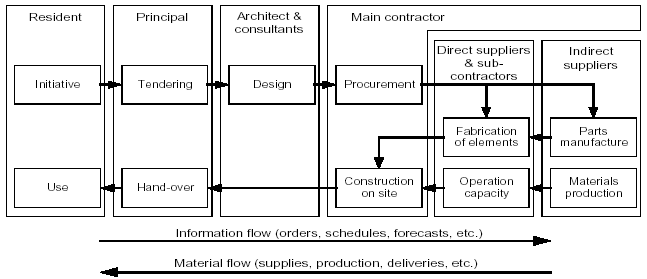
As seen in the above illustration, a linkage has been formed between different actors and these include the resident, principal, architects and the main contractor. Most of the action and cost is in the domain of the main contractor. The contractor would be having a number of links such as vendors and suppliers who supply the raw material, equipment and machines. For the supply chain to work efficiently, each link has to know when and in what quantities the required products have to be supplied. Please refer to the following image that gives the work breakdown structure and shows how the links are interconnected.

A simulation for the supply chain has been created using the Scitor PS Suite 8 software application. In the above figure, key links of the supply chain have been illustrated along with the time lines. Different colour blocks represent the activities for a task that are listed in the left column. The ideal supply chain would be able to anticipate the starting and ending times for different tasks and inform the next links to supply the material, labour, equipment as per the task basis.
What are current issues and trends in this area?
The current issues and trends in this area are about planning for complex projects where the failure rate is high and cost of failures can run into millions of dollars. Complex projects have been provided with different definitions and Cagno (2007) defines them as “Complex projects is defined by the number of interacting parts, components or stages” while Howley (2007) defines complex projects “as having a number of modules with feedback loops that often drive each other and impact the performance of each other, like a mechanical watch“.
On the other hand Cavaleri (2007) speaks of complex projects as “having dynamically varying multiple elements, many over which the project manager has no control and all he can do is to identify the risk”‘. Walker (2007) says that complexity of a project is very related to decision making. “It is identified by the large number of specialists who help in the decision-making process so it is integral with the organization structure. Complexity determines the manner in which people work to produce the output that forms the basis on which decisions are made and this means that the level of complexity can be determined by the decision making which should be interrelated too the organization structure”.
Thus it can be seen that there are a number of definitions for complex projects, however, a review of published literature concurs that while managing conventional or straight projects is a question of managing cost, time and quality, complex project management require much more and different methods. Such projects “need a multi dimensional approach with extensive non-linearity, radical unpredictability, self-organization, and emergence and has critical implications for the un-codified paradigm that underpins project management practice and research” (Davies, 2007).
Difficulties in Complex Project Planning
There are a number of issues that make complex different from conventional projects. Some examples of complex projects are an automobile project for low cost car that involves market research, design, prototyping, testing, manufacturing and assembly and finally marketing; large construction projects such as dam construction where there are different tasks such as site identification and acquisition, dam construction, electric transformers and power generation, power transmission and distribution and utility network set up for end customers; extra terrestrial satellite projects; large IT projects such as NHS and many others.
One common theme about these projects is that there are many critical variables that vary dynamically but have a critical impact on the project deliverables and results. Varying dynamically refers to unanticipated changes that can be triggered by external forces (Williams, 1997).
Complex projects are often subject to multiple objectives and success would only be achieved when all these objectives are fully met. In many cases, these objectives would depend on factors that cannot be controlled by the project manager and the factors are created by the business and the political environment. The above examples are explained discussed to understand the meaning of dynamically variable factors (Williams, 1997).
Table 3.1. Differences between Planning for Traditional and Complex Projects.
Planning Traditional Projects
Traditional projects, irrespective of the budget and size of the projects can be managed by using standard project management techniques. Since the variables are linear in nature, they can be represented, tracked and monitored by using standard Gnatt charts, PERT and other techniques. An illustration of project management techniques is given in the following figure.
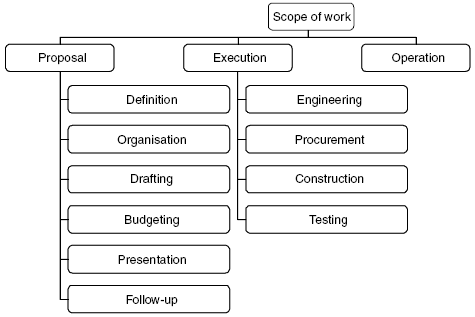
As seen in the above figure, in traditional projects, the scope of work clearly includes the proposal, execution and operation and the work breakdown structure is straightforward. The proposal definition is clearly specifies the definition, organisation of the project, drafting, budgeting, presentation and follow up. Once the proposal is accepted, the execution phase comes in. There is no chance of scope creep or issues of project definitions not being correct. It is possible to track the performance in terms of cost, time and delivery. This does not indicate that traditional projects are easy to implement but it is only asserted that all risks are identified and project management is straightforward (Markland, 2007).
Planning Complex Projects
In contrast, complex projects need to have a different project management method and traditional framework would not be suitable since the risks and independent variables have a different nature. Cagno (2007) has identified a framework that can be used for complex project management and project risk identification assumes a critical aspect. Please refer to the following figure that illustrates the framework.
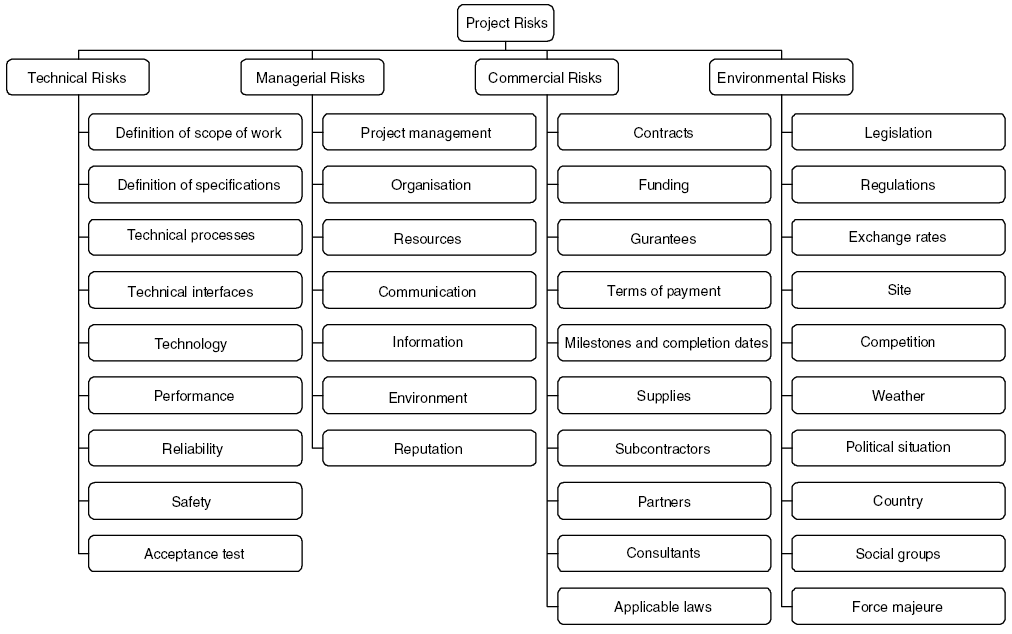
As seen in the above figure, complex project management involves identifying the project risks and these are made of technical risks, managerial risks, commercial risks and environmental risks. Technical risks include definition of work scope and specifications, technical interfaces, technology to be used, performance parameters, reliability, safety and acceptance test. All these risks must be identified at the project scope and definition stage.
In the eventuality that some technical issues remain unresolved, then the project would fail. Next come the managerial roles and the problem with complex projects is in identifying the central project management office. With a central PMO that controls all the activities, management is possible but when different entities are involved, a central PMO often becomes toothless and cannot keep track of the activities and this is a weak area.
In many cases, when the complex project has a social objective or when such an objective is added as an afterthought, political appointees with little understanding of the project assume positions of power and can result in a disaster. The PMO needs to be central to the organisation, identify and manage the resources, use close and direct communication with the parties, allow information to flow in both directions and issues related to the environment and reputation should not arise (Cagno, 2007).
Commercial risks pose one of the greatest risks to complex projects and are often the most severe independent variables that can bring down a project. Factors include contracts and these include not only the contracts between vendors and suppliers but end users of the structure. If a road was built and a tollbooth was opened to recoup the expenses, people could use alternate routes to bypass the toll and the road would be a commercial failure.
There is no assurance that such an event would not happen. Project costing is done on estimations for traffic and a revenue model is created based on predefined prices. If the prices are reduced due to political pressures, then the revenues go down and the project becomes commercially unviable. Other variables are funding, guarantees, terms of payment, milestones of completion dates, supplies, subcontractors, partners, consultants and applicable laws.
There are also a number of environmental risks and these refer to the business and political environment in which the project would operate. Some of the factors are legislations, regulations and exchange rates, over which the project manager has no control. Then there are the market forces such as the exchange rate, site issues and the competition activities. There are also issues such as political situation, country risk profile and this can have a serious effect in developing countries where the political climate is unstable and social groups that may support the project or protest against it. The last factor is the Force majeure that can be used when conditions go out of hand and it is not possible to complete the project. (Cagno, 2007).
Thus, it can be seen that project management techniques used in complex projects are different from those used in traditional projects. Complex projects cannot be managed by using standard performance indicators such as cost, time and quality and while these define the result, progress of the project needs to have a full risk management strategy.
Conclusions
The paper has researched the foundations of planning and examined the theoretical and practical aspects of planning. A number of examples of project planning in the construction industry along with complex projects and a few well known and iconic projects have been discussed. The following set of conclusions and summations are provided for the paper.
- Planning involves defining the organization’s goals, establishing an overall strategy, and developing a comprehensive set of plans to integrate and coordinate organizational work.
- A formal planning system has properly documented instructions with specific goals and a specific action programs exist to achieve goals. Planning is the primary management function that establishes the basis for all other management functions and establishes coordinated effort, reduces uncertainty, reduces overlapping and wasteful activities and establishes goals and standards used in controlling performance and actions. Formal planning is associated with higher profits and higher return on assets.
- A proper and well documented planning system is very important for a project to be tracked and to understand it is a success or a failure.
- A lack of adequate planning causes schedules to be missed, budget to be overruns so that the firm spends three or four times the budgeted amount and there is also an expensive delay in the project.
References
AP, 2008. Eurotunnel reports net earnings of €26 million. [Online] International Herald Tribune Online. Web.
Bennett John, 2000. Construction the Third Way, Managing Cooperation and Competition in Construction, New York. Butterworth-Heinemann.
Bourne. L., Walker. D., 2005. The paradox of project control. Team performance and management journal, 11(5/6), pp: 157-197.
Cagno. Enrico., & Caron. Franco., 2007. A Multi-Dimensional Analysis of Major Risks In Complex Projects. Journal of Risk Management, 9, pp: 1-18.
Chileshe Nicholas, Haupt Theo C, 2005. Modeling critical success factors of construction project management, Journal of Engineering Design and Technology, Volume 3, No. 2, 140: 154.
Cheng Min-Yuan, Su Cheng-Wei, February 2003. Optimal Project Organizational Structure for Construction Management. Journal of Construction, Engineering and Management, Volume 129, Issue 1, 70-79.
Ellram Lisa M, 2000. Purchasing and Supply Management’s Participation in the Target Costing Process, The Journal of Supply Chain Management, Volume 36, Issue 2, 39-47.
Gruneberg Stephen L. 2000. The Economics of the Modern Construction Firm, UK, Mac Millan.
Kelly John, Male Steven, Graham Drummond, 2002. Value Management of Construction Projects, 1st Edition, Wiley-Blackwell.
Markland. Margaret., & Butters. Geoff., 2007. The History of the Future: evaluating projects and service developments before they begin. Journal of Performance Measurement and Metrics, 8(1), pp: 34-40.
McGeorge Denny, Palmer Angela, 2002. Construction Management: New Directions, 2nd Edition, UK, Wiley-Blackwell.
PAFF, 2007. The Port Adelaide Flower Farm Project. Australian Horticulture Department. Web.
Pryke Stephen, Smyth Hedley, 2006. The Management of Complex Projects: A Relationship Approach, UK, Wiley-Blackwell.
Scitor PS Suite 8, 2008. Resource Modeling: SciForma Corporation. Web.
Stephen P Robbins, Coulter Mary, 2002. Chapter 7, Foundations of Planning in Management. Prentice Hall Publications.
Thompson AA, Strickland AJ, 1995. Creating and implementing strategy. Chicago, Irwin Publications.
Udechukwu. Ojiako., & Johansen. Eric., 2007. A qualitative re-construction of project measurement criteria. Industrial Management & Data Systems, 108(3), pp: 405-417.
Vrijhoef Ruben, Koskela Lauri, 1999. Roles of Supply Chain Management in Construction, University of California, Berkeley, CA, USA. Web.
White, Isobel,. 2005. Building the Scottish Parliament, The Holyrood Project. [Online] House of Commons, London. Web.
Williams. T.M., 1997. Managing and Modeling Complex Projects. Springer Publications.